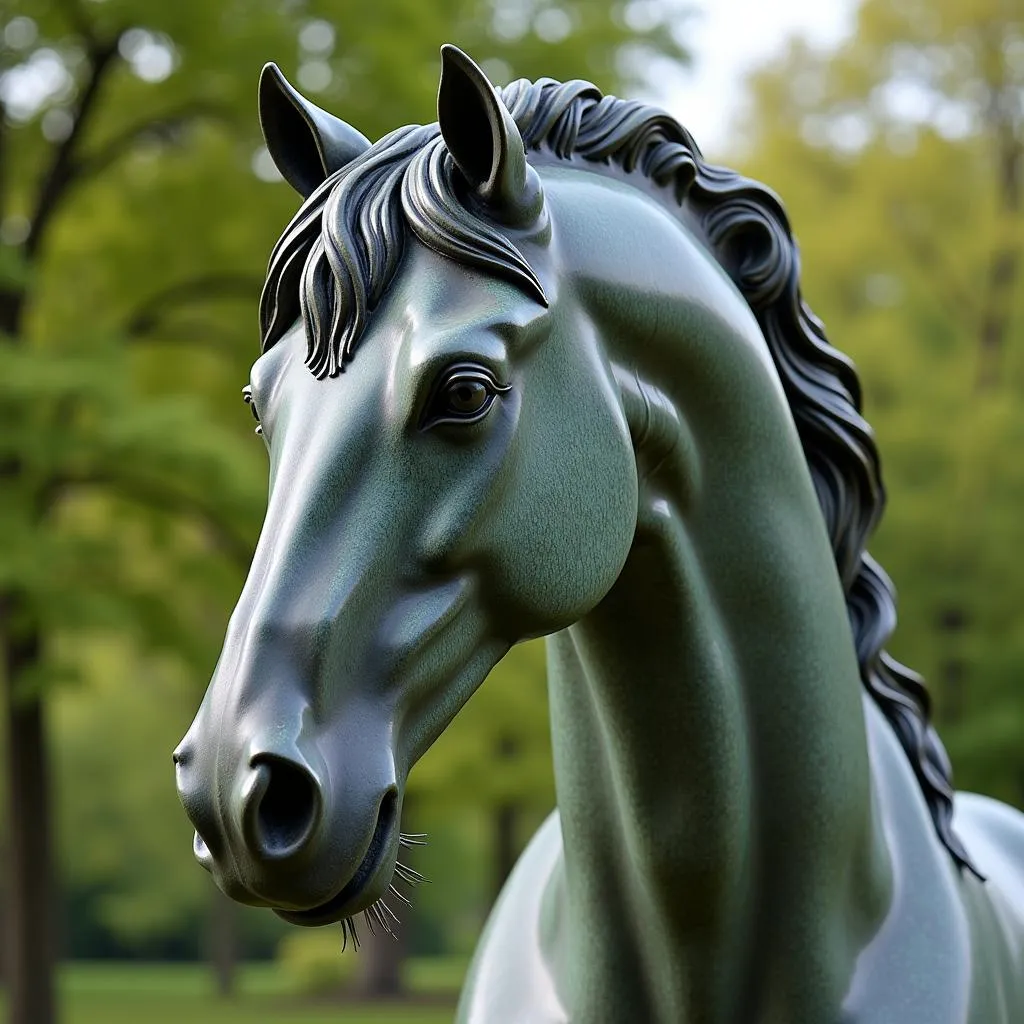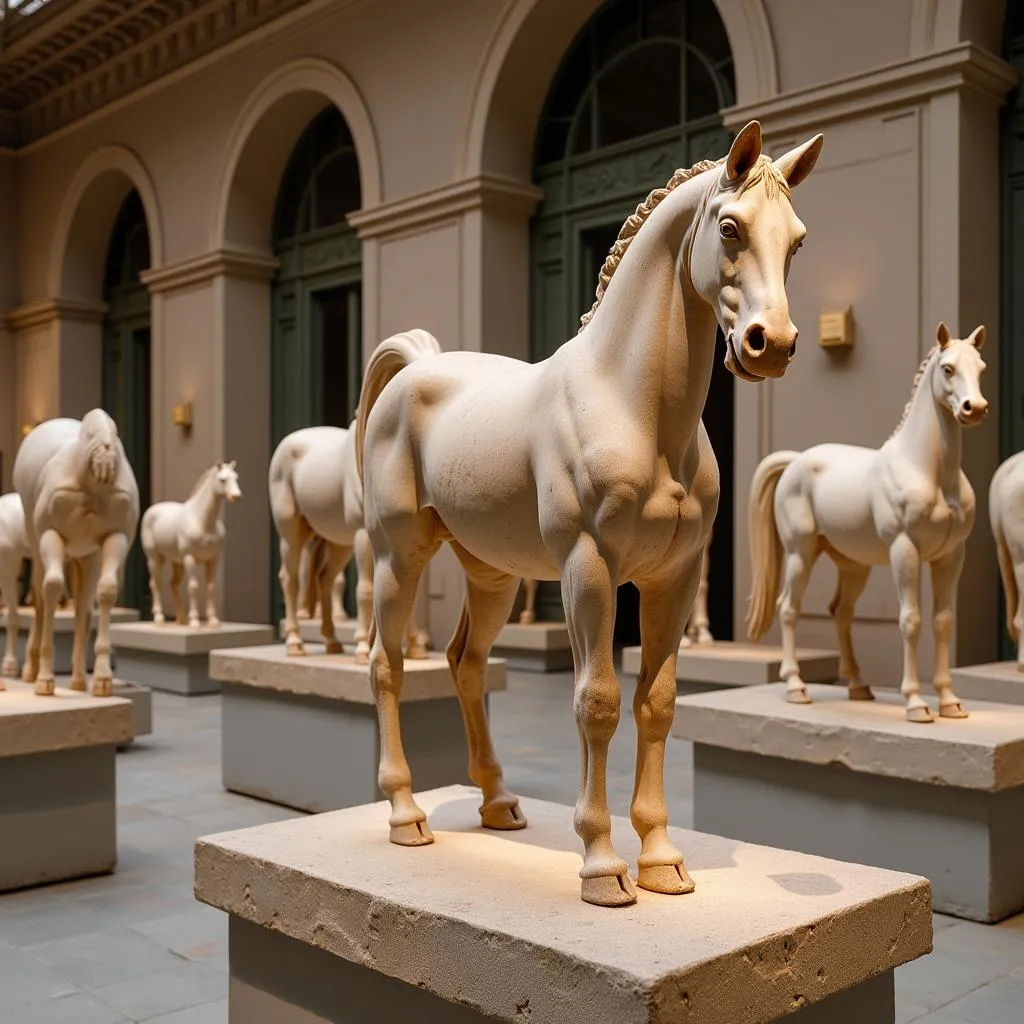Horse Statues have captivated humanity for centuries, serving as powerful symbols of strength, grace, and companionship. From ancient civilizations to modern art installations, these sculptures offer a glimpse into our enduring fascination with these magnificent creatures. But what is it about horse statues that continues to resonate with us today?
 Majestic bronze horse statue in a park
Majestic bronze horse statue in a park
The Enduring Appeal of Equine Art
Throughout history, horses have played an integral role in shaping human civilization, serving as trusted companions in war, agriculture, and transportation. This deep-rooted connection is reflected in the art world, where horses have been a recurring motif across cultures and artistic movements.
Horse Statues: More Than Just Decorations
Horse statues are much more than simply decorative elements. They often embody a complex tapestry of symbolism and meaning. Depending on the context, a horse statue can represent:
- Power and Nobility: Think of the imposing equestrian statues of valiant warriors and rulers, such as the iconic Marcus Aurelius statue in Rome. These sculptures convey a sense of authority, courage, and leadership.
- Freedom and Spirit: Depictions of horses in dynamic poses, such as rearing or galloping, often symbolize the untamed spirit, freedom, and unbridled energy these animals embody.
- Grace and Beauty: The elegant lines and fluid movements of horses have inspired countless artists. Horse statues often capture this innate grace, serving as timeless tributes to the beauty of the natural world.
A Journey Through Time: Exploring Different Styles of Horse Statues
 Ancient Greek marble horse sculptures
Ancient Greek marble horse sculptures
The artistic interpretation of horse statues has evolved significantly throughout history, reflecting changing cultural perspectives and artistic sensibilities. Let’s take a journey through time to explore some notable styles:
- Ancient World: Ancient Egyptian, Greek, and Roman civilizations all produced stunning horse sculptures, often depicting horses as divine creatures or symbols of power. These early works laid the foundation for the enduring legacy of equine art.
- Renaissance and Baroque: The Renaissance period witnessed a renewed interest in classical art, leading to a surge in equestrian statues that celebrated humanism and anatomical accuracy. Baroque sculptures, known for their dynamism and theatricality, often featured horses in dramatic poses, conveying a sense of movement and energy.
- 19th and 20th Centuries: The 19th and 20th centuries saw a diversification of styles, with artists exploring Impressionism, Realism, and Modernism. Horse statues from this era range from romantic depictions of wild horses to abstract interpretations of equine form.
Bringing Home the Majesty: Choosing the Perfect Horse Statue for You
 Variety of horse statues for sale
Variety of horse statues for sale
Whether you’re a lifelong equestrian enthusiast or simply appreciate the beauty and symbolism of these majestic creatures, there’s a horse statue out there to complement any space. Here are a few factors to consider when selecting the perfect piece:
- Material: Horse statues are crafted from a wide array of materials, each offering a unique aesthetic appeal. Bronze is a classic choice, known for its durability and timeless elegance. Other popular options include wood, ceramic, resin, and even glass.
- Style: From realistic depictions to abstract interpretations, the style of your chosen horse statue should resonate with your personal taste and complement the existing decor of your home or garden.
- Size and Scale: Consider the dimensions of the space where you envision displaying your horse statue. A life-size sculpture might be fitting for a spacious garden, while a smaller figurine might be more suitable for a bookshelf or mantelpiece.
“When selecting a horse statue, it’s essential to choose a piece that speaks to your heart,” says renowned sculptor and horse enthusiast, Emily Carter. “Look for sculptures that evoke a sense of emotion and connection. After all, a well-crafted horse statue is more than just an object; it’s a work of art that can bring joy for years to come.”
Conclusion
Horse statues continue to captivate and inspire us with their timeless beauty, symbolism, and artistic expression. Whether you’re drawn to their historical significance, their representation of equine grace, or simply their aesthetic appeal, these sculptures offer a unique window into our enduring fascination with these magnificent creatures.
FAQs
1. What are the most common materials used to make horse statues?
Bronze, resin, wood, and ceramic are popular choices for horse statues.
2. Where can I buy a horse statue?
You can find horse statues at art galleries, antique shops, online retailers, and specialized equestrian stores.
3. How do I care for my horse statue?
Cleaning and maintenance requirements vary depending on the material. Generally, dusting regularly and using appropriate cleaning products will help preserve the beauty of your statue.
4. What is the significance of a rearing horse statue?
Rearing horse statues often symbolize power, strength, and victory.
5. Do horse statues come in different sizes?
Yes, horse statues are available in a wide range of sizes, from miniature figurines to life-size sculptures.
Interested in learning more about bronze horse and cowboy statue? Explore our website for a captivating collection of equine art and insightful articles on all things horses.
For any inquiries or assistance, please reach out to us at Phone Number: 0772127271, Email: [email protected], or visit our address: QGM2+WX2, Vị Trung, Vị Thuỷ, Hậu Giang, Việt Nam. Our dedicated customer support team is available 24/7 to assist you.